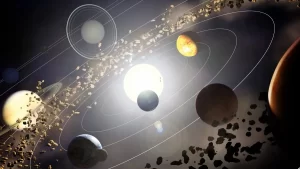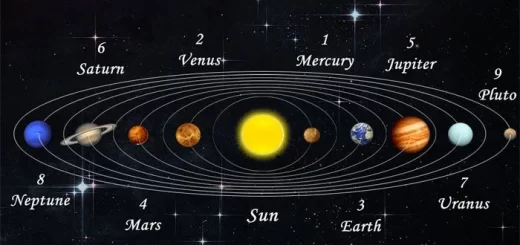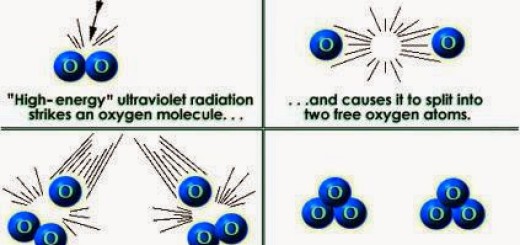Crossing star theory, Modern theory of the world and difference in length of day and year
The Crossing Star Theory, proposed by Thomas C. Chamberlin and Forest R. Moulton in 1905, is an early scientific hypothesis about the origin of the solar system. It is also commonly referred to as the Planetesimal Hypothesis.
The crossing star theory (Chamberlain and Moulton 1905)
The assumptions of the crossing star theory assumed that the solar system was originally the Sun, A huge star approached the Sun, This star attracted the Sun to it which led to a great expansion in the part of the Sun facing it.
This expanded part was exploded which led to a gaseous line was formed of a great length from the Sun, and the Sun escaped from the gravity of that star, The gaseous line started to condense due to the attraction force, and then it cooled forming the planets.
The crossing star theory suggests that the solar system was formed as a result of a close encounter between a passing star and the Sun. During this event:
- A passing star came close enough to the Sun to exert a strong gravitational force.
- This gravitational interaction caused massive amounts of gaseous material to be ejected from the Sun. Some material may also have been contributed by the passing star.
- The ejected material cooled and condensed into small solid bodies, called planetesimals.
- Over time, these planetesimals collided and coalesced due to gravitational attraction, eventually forming the planets and other bodies in the solar system.
Features of the Theory
- The hypothesis introduced the concept of planetesimals as the building blocks of planets.
- It relies on the idea that a near collision with another star could explain the Sun‘s loss of material and the creation of the planets.
- The planets were thought to form slowly through the accumulation of smaller solid bodies.
Limitations and Criticism
While the Crossing Star Theory was an innovative idea for its time, it was later deemed unlikely due to several reasons:
- The theory requires a star to pass extremely close to the Sun, which is highly improbable given the vast distances between stars.
- Ejected gas from the Sun would not cool and condense into solid bodies as described. Instead, it would likely disperse in space due to its high velocity and temperature.
- The Nebular Hypothesis, which suggests that the solar system formed from the gravitational collapse of a molecular cloud, is now the widely accepted theory.
Despite its shortcomings, the Crossing Star Theory contributed to the development of planetary science by:
- Introducing the concept of planetesimals.
- Sparking further discussion and research on the formation of the solar system.
- Highlighting the importance of gravitational interactions in shaping celestial systems.
Today, the theory is considered an important historical step in understanding solar system formation, even though it has been replaced by more accurate models.
The modern theory of the world (Alfred Hale 1944)
Scientists sometimes observe a star greatly glows for a short time to become one of the most shining stars in the sky, After a day or two, its glowing disappears gradually to return to its normal nature.
The reason for that glowing is not known, It may be due to the explosion of the star as a result of the nuclear reactions that occur in it suddenly and violently.
The star bombs huge amounts of gaseous materials when these reactions occur, then its size increases, when the bombed gases are cooled, the star shining returns as it was, Alfred Hale used this fact to develop his assumptions about the solar system evolution.
The assumptions of Alfred Hale (modern theory)
Alfred Hale assumed that the solar system was originally a star rather the Sun, A star was rotating near the Sun, The star exploded due to huge nuclear reactions, The force of the explosion led to the bombing of star’s nucleus away from the gravity of the Sun, A cloud of gas remained.
The gaseous cloud is subjected to cooling and contraction processes forming the matter of planets then the attraction force of the Sun controls the orbits of planets around it.
The difference in the length of the day and year from a planet to another
The Earth revolves around its axis in a period of time estimated at one Earth’s day and it revolves around the Sun in a period of time estimated at one Earth’s year.
The Earth’s day is the time taken by the Earth planet to make one complete rotation around its axis while the Earth’s year is the time taken by the Earth planet to make one complete rotation around the Sun.
The Earth’s year = 365.25 Earth’s day, The Earth day = 24 Earth’s hour, There are many factors controlling the difference in the length of the day and year from one planet to another.
The factors that led to the difference in the length of the day are the radius of the planet and the speed of rotation of the planet around its axis, The day is the period taken by the planet to make one complete rotation around its axis.
The factors led to the difference in the length of the year are the distance between the planet and the Sun, And the speed of rotation of the planet around the Sun, The year is the period taken by the planet to make one complete rotation around the Sun.
Universe, Galaxies, Milky Way galaxy, Solar System, Origin of Universe & Stages of Big Bang
Nebular theory, Crossing star theory, Modern theory, Solar telescope & Hubble telescope




